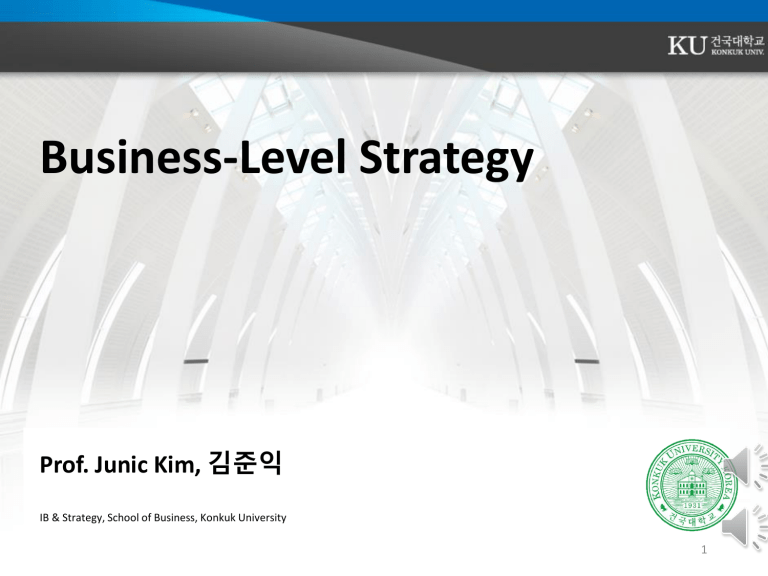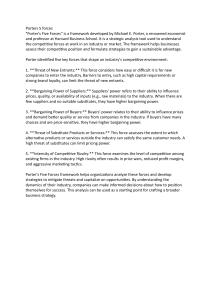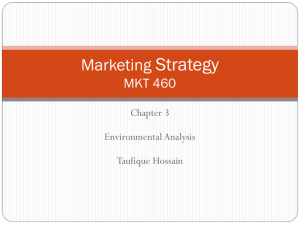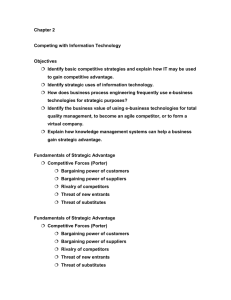
Business-Level Strategy Prof. Junic Kim, 김준익 IB & Strategy, School of Business, Konkuk University 1 Opening Case: LG Styler 2 Learning Objectives 1. Define business-level strategy. 2. Discuss the relationship between __________ and businesslevel strategies in terms of ________________. 3. Explain the differences among business-level strategies. 4. Use the _________________ to explain how above-average returns can be earned through each business-level strategy. 5. Describe the risks of using each of the business-level strategies. 3 Business-Level Strategy (Defined) • Business-Level Strategy: An integrated and coordinated set of commitments and actions the firm uses to gain a competitive advantage by _____________________________ • ____________________________________. 4 Core Competencies and Strategy Core Competencies Resources and superior capabilities that are sources of ___________________ over a firm’s rivals Strategy An integrated and coordinated set of actions taken to exploit core competencies and gain competitive advantage Business-level Strategy Providing value to customers and gaining competitive advantage by exploiting core competencies in individual product markets 5 Customers: Their Relationship with Business-Level Strategies 6 Customers: Their Relationship with Business-Level Strategies Customers are the foundation of successful business-level strategies. 7 Who: Determining the Customers to Serve • Market segmentation – A process used to cluster people with similar needs into individual and identifiable groups. All Customers Consumer Markets Industrial Markets 8 Market Segmentation (cont’d) 9 Market Segmentation (cont’d) 10 What: Determining Which Customer Needs to Satisfy • Customer needs are related to a ________________ _____________________. • Customer needs are neither right nor wrong, good nor bad. • Customer needs represent _____________________ ______________________. 11 How: Determining Core Competencies Necessary to Satisfy Customer Needs • Firms must decide: – who to serve, what customer needs to meet, and how to use core competencies to implement value creating strategies that satisfy target customers’ needs. • Only firms with capacity to _____________________ _____________________________ can expect to meet and/or exceed customer expectations across time. 12 The Purpose of a Business-Level Strategy • Business-Level Strategies: – are intended to _______________ between the firm’s competitive position and those of its competitors. • To position itself, the firm must decide whether it intends to: I. perform activities differently or II. perform different activities as compared to its rivals. 13 Types of Potential Competitive Advantage • Achieving lower overall costs than rivals – Performing activities differently (reducing process costs) • Possessing the capability to differentiate the firm’s product or service and command a premium price – Performing different (more highly valued) activities. 14 Competitive Scope • _______ Scope – The firm competes in many customer segments. • _______ Scope – The firm selects a segment or group of segments in the industry and tailors its strategy to serving them at the exclusion of others. 15 Business Level Strategies 16 Business Level Strategies 17 1) Cost Leadership Strategy • An integrated set of actions taken to produce goods or services with features ____________________ _____________, relative to that of competitors. • Product Characteristics – Relatively standardized (commoditized) products – Features broadly acceptable to many customers – Lowest competitive price 18 1) Cost Leadership Strategy • Cost saving actions required by this strategy – Building efficient scale facilities – Tightly controlling production costs and overhead – Minimizing costs of sales, R&D and service – Building efficient manufacturing facilities – Monitoring costs of activities provided by outsiders – Simplifying production processes 19 How to Obtain a Cost Advantage Determine and control Cost Drivers Reconfigure Value Chain if needed ▪ Alter production process ▪ New raw material ▪ Change in automation ▪ Forward integration ▪ New distribution channel ▪ Backward integration ▪ Change location relative to suppliers or buyers ▪ New advertising media ▪ Direct sales in place of indir ect sales 20 Value-Creating Activities for Cost Leadership 21 Value-Creating Activities for Cost Leadership • Cost-effective MIS • Few management layers • Simplified planning • Consistent policies • Effecting training • Easy-to-use manufacturing technologies • Investments in technologies • Finding low-cost raw materials • Monitor suppliers’ performances • Link suppliers’ products to production processes • Economies of scale • Efficient-scale facilities • Effective delivery schedules • Low-cost transportation • Highly trained sales force • Proper pricing 22 Value-Creating Activities for Cost Leadership 23 1) Cost Leadership Strategy: Competitors • Due to cost leader’s Rivalry with Existing Competitors advantageous position: Threat of new entrants – rivals hesitate to compete on basis of price. – lack of price competition leads to greater profits. Rivalry among competing firms Threat of substitute products Bargaining power of suppliers Bargaining power of buyers 24 1) Cost Leadership Strategy: Buyers • Can mitigate buyers’ Bargaining Power of Buyers power by: Threat of new entrants – driving prices far below competitors, causing them to exit, thus shifting power with buyers (customers) back to the Rivalry among competing firms Threat of substitute products Bargaining power of suppliers Bargaining power of buyers firm. 25 1) Cost Leadership Strategy: Suppliers • Can mitigate suppliers’ Bargaining Power of Suppliers power by: Threat of new entrants – being able to absorb cost increases due to low cost position. – being able to make very large purchases, reducing chance of Rivalry among competing firms Threat of substitute products Bargaining power of suppliers Bargaining power of buyers supplier using power. 26 1) Cost Leadership Strategy: New Entrants The Threat of Potential Entrants • Can frighten off new entrants due to: Threat of new entrants Rivalry among competing firms Threat of substitute products – their need to enter on a Bargaining power of suppliers Bargaining power of buyers large scale in order to be cost competitive. – the time it takes to move down the industry learning curve. 27 1) Cost Leadership Strategy: Substitutes Product Substitutes leader is well positioned to: – lower prices in order to maintain Threat of new entrants Rivalry among competing firms Comparing with substitutes, cost its value position. Bargaining power of suppliers – make investments to add features unavailable in substitutes. Threat of substitute products Bargaining power of buyers – buy intellectual property and patents developed by potential substitutes. 28 1) Cost Leadership Strategy • Competitive Risks – Processes used to produce and distribute good or service may become obsolete due to competitors’ innovations. – Too much focus on cost reductions may occur at expense of customers’ perceptions of differentiation. – Competitors, using their own core competencies, may successfully imitate the cost leader’s strategy. 29 2) Differentiation Strategy 30 2) Differentiation Strategy • An integrated set of actions taken to produce goods or services (at an acceptable cost) that customers ___________________________ _______________________. – Focus is on non-standardized products – Appropriate when customers value differentiated features more than they value low cost 31 2) How to Obtain a Differentiation Advantage Control Cost Drivers if needed Reconfigure Value Chain to maximize ▪ Lower buyers’ costs ▪ Raise performance of product or service ▪ Create sustainability through: • customer perceptions of uniqueness • customer reluctance to switch to nonunique product or service 32 2) Value-Creating Activities and Differentiation 33 2) Value-Creating Activities and Differentiation • Highly developed MIS • Emphasis on quality • Worker compensation for creativity/productivity • Use of subjective performance measures • Basic research capability • Technology • High quality raw materials • Delivery of products • High quality replacement parts • Superior handling of incoming raw materials • Attractive products • Rapid response to customer specifications • Order-processing procedures • Customer credit • Personal relationships 34 2) Differentiation Strategy: Competitors Rivalry with Existing Competitors competitors because Threat of new entrants Rivalry among competing firms Threat of substitute products • Defends against _______________ Bargaining power of suppliers Bargaining power of buyers _______________ _______________ offsets price competition. 35 2) Differentiation Strategy: Buyers Bargaining Power of Buyers • Can mitigate buyers’ power because well Threat of new entrants Rivalry among competing firms Threat of substitute products differentiated Bargaining power of suppliers Bargaining power of buyers products reduce customer sensitivity to price increases. 36 2) Differentiation Strategy: Suppliers Bargaining Power of Suppliers • Can mitigate suppliers’ power by: Threat of new entrants Rivalry among competing firms Threat of substitute products – absorbing price increases Bargaining power of suppliers Bargaining power of buyers due to higher margins. – passing along higher supplier prices because buyers are loyal to a differentiated brand. 37 2) Differentiation Strategy: New Entrants The Threat of Potential Entrants • Can defend against new entrants because: Threat of new entrants Rivalry among competing firms Threat of substitute products – new products must Bargaining power of suppliers Bargaining power of buyers surpass proven products. – new products must be at least equal to performance of proven products, but offered at lower prices. 38 2) Differentiation Strategy: Substitutes Product Substitutes Threat of new entrants Rivalry among competing firms Threat of substitute products Bargaining power of suppliers Bargaining power of buyers • Well-positioned relative to substitutes because: – brand loyalty to a differentiated product tends to reduce customers’ testing of new products or switching brands. 39 2) Competitive Risks of Differentiation • The price differential between the differentiator’s product and the cost leader’s product becomes too large. • Differentiation ceases to provide value for which customers are willing to pay. • Experience narrows customers’ perceptions of the value of differentiated features. • Counterfeit goods replicate the differentiated features of the firm’s products. 40 3) / 4) Focus Strategies Focus Strategies 414–41 3) / 4) Focus Strategies • An integrated set of actions taken to produce goods or services that serve the needs of a particular competitive segment. – Particular buyer group—youths or senior citizens – Different segment of a product line—professional craftsmen versus do-it-yourselfers – Different geographic markets—east coast versus west coast, northern and southern Italy 424–42 3) / 4) Focus Strategies • Strategic plan under which a firm concentrates its resources on entering or expanding in a narrowly defined market segment. • The firm focuses on a narrow niche market in which to build a strong competitive advantage. • It is usually employed where the firm knows its segment and has products to competitively satisfy its needs. • Focus allows businesses to compete on the basis of low cost, differentiation, and rapid responses against much larger businesses with larger resources. • The objective of the firm is to do a better job at serving the buyers in the target market than the rivals. 434–43 3) / 4) Focus Strategies • __________ – A niche is a more narrowly defined customer group seeking a distinctive mix of benefits. Marketers usually identify niches by dividing a segment into sub segments. – In focusing Strategy the key to success is _________ _______________ where buyers have distinctive preferences, special requirements, or unique needs and developing a unique ability to serve those needs. 444–44 3) / 4) Focus Strategies Dollar General, targets poor urban American families who can not drive to Wal-marts in the suburbs because they do not own a car. It is now a growing Fortune 500 Company. 454–45 3) / 4) Focus Strategies • What make a segment attractive for focusing? – Size of the segment is big enough to be profitable – Size of the segment is small enough to be of secondary interest to large rivals – Has good growth potential – Less vulnerable to substitutes – Not crucial to the success of major competitors – Buyers in the segment require specialized expertise OR customized product attributes – No other rivals are concentrating on the segment 464–46 3) / 4) Focus Strategies 474–47 3) / 4) Focus Strategies a premier specialty household appliance manufacturer in Korea. 484–48 3) / 4) Focus Strategies Dimchae Kimchi Refrigerator 494–49 3) / 4) Focus Strategies Since 2011, Kimchi refrigerator has over 90% penetration rate in Korea. 504–50 3) / 4) Focus Strategies The most wanted item for newlyweds? 514–51 3) / 4) Focus Strategies • Types of focused strategies – 3) Focused cost leadership strategy – 4) Focused differentiation strategy • To implement a focus strategy, firms must be able to: – complete various primary and support activities in a competitively superior manner, in order to develop and sustain a competitive advantage and earn aboveaverage returns. 524–52 3) / 4) Focus Strategies 3) Focused cost leadership strategy 534–53 3) / 4) Focus Strategies 4) Focused differentiation strategy Digestible Milk 544–54 3) / 4) Factors That Drive Focused Strategies • Large firms may overlook small niches. • A firm may lack the resources needed to compete in the broader market. • A firm is able to serve a narrow market segment more effectively than can its larger industry-wide competitors. • Focusing allows the firm to direct its resources to certain value chain activities to build competitive advantage. 554–55 3) / 4) Competitive Risks of Focus Strategies • A focusing firm may be “out focused” by its competitors. • A large competitor may set its sights on a firm’s niche market. • Customer preferences in a niche market may change to more closely resemble those of the broader market. 564–56 5) Integrated Cost Leadership/Differentiation Strategy 57 5) Integrated Cost Leadership/Differentiation Strategy • A firm that successfully uses an integrated cost leadership/differentiation strategy should be in a better position to: – adapt quickly to environmental changes. – learn new skills and technologies more quickly. – effectively leverage its core competencies while competing against its rivals. 584–58 5) Integrated Cost Leadership/Differentiation Strategy • Commitment to _________________ is necessary for implementation of integrated cost leadership/ differentiation strategy. 594–59 Risks of an Integrated Cost Leadership/ Differentiation Strategy • Often involves compromises – Becoming neither the lowest cost nor the most differentiated firm • Becoming “stuck in the middle” – Lacking the strong commitment and expertise that accompanies firms following either a cost leadership or a differentiated strategy 604–60 Conclusions • A business-level strategy is an integrated an coordinated set of commitments and actions the firm uses to gain a competitive advantage by exploiting core competencies in specific product markets. • Five business-level strategies (cost leadership, differentiation, focused cost leadership, focused differentiation, and integrated cost leadership/differentiation) are examined in this lecture. 61 Discussion • Please introduce the innovative business strategies you know! And let's consider which type of business-level strategies belongs to. 624–62 Q&A 63







